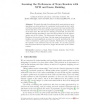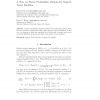107
click to vote
EMNLP
2009
14 years 10 months ago
2009
We present a framework to extract the most important features (tree fragments) from a Tree Kernel (TK) space according to their importance in the target kernelbased machine, e.g. ...
CIKM
2010
Springer
14 years 10 months ago
2010
Springer
Individuals often use search engines to return to web pages they have previously visited. This behaviour, called refinding, accounts for about 38% of all queries. While researcher...
ACL
2010
14 years 10 months ago
2010
Most sentiment analysis approaches use as baseline a support vector machines (SVM) classifier with binary unigram weights. In this paper, we explore whether more sophisticated fea...
PAMI
2010
14 years 10 months ago
2010
—This paper addresses pattern classification in the framework of domain adaptation by considering methods that solve problems in which training data are assumed to be available o...
106
click to vote
IFIP12
2010
14 years 10 months ago
2010
We attack the task of predicting which news-stories are more appealing to a given audience by comparing ‘most popular stories’, gathered from various online news outlets, over ...
ICASSP
2010
IEEE
14 years 10 months ago
2010
IEEE
Prosodic information has been successfully used for speaker recognition for more than a decade. The best-performing prosodic system to date has been one based on features extracte...
ICASSP
2010
IEEE
14 years 10 months ago
2010
IEEE
In this paper, we introduce a novel bayesian compressive sensing (CS) technique for phonetic classification. CS is often used to characterize a signal from a few support training...
NECO
2007
14 years 11 months ago
2007
Most literature on Support Vector Machines (SVMs) concentrate on the dual optimization problem. In this paper, we would like to point out that the primal problem can also be solve...
ML
2007
ACM
14 years 11 months ago
2007
ACM
Platt’s probabilistic outputs for Support Vector Machines (Platt, 2000) has been popular for applications that require posterior class probabilities. In this note, we propose an ...
104
click to vote
VLDB
2002
ACM
14 years 12 months ago
2002
ACM
Abstract. Support vector machines (SVMs) have shown superb performance for text classification tasks. They are accurate, robust, and quick to apply to test instances. Their only po...


